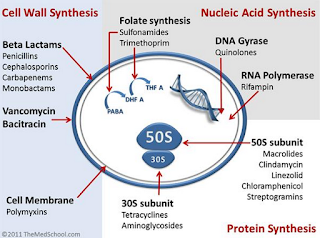An Overview On Various types of Antibiotics Mechanism of Action
Antibiotics
Mechanism of Action
1.
Cell Wall Synthesis:
Penicillins:
Mechanism of Action: Interferes with bacterial cell wall synthesis.
Cephalosporines:
Mechanism of Action: Disrupts the synthesis of the peptidoglycan layer
of bacterial cell walls.
Sub-Categories:
Ø
first
generation
Ex.
Cephalothin, Cephazolin.
Ø
second
generation
Ex.
Cefaclor, Cefuroxime.
Ø
third
generation
Ex.
Cefixime, Ceftriaxone.
Ø
fourth
generation
Ex.
Cefepime.
Ø
Fifth generation
Ex.
Ceftobiprole.
Vancomycin
Mechanism of Action: Bactericidal, an inhibitor of cell wall synthesis.
2.
Nucleic Acid Synthesis:
Fluoroquinolones
Mechanism of Action: Blocks DNA replication via inhibition of DNA
gyrase.
Subclassification
and tested examples:
Ø Ciprofloxacin
Ø Levofloxacin
3. 30s Sub-Unit Ribosome Inhibition:
Aminoglycosids
Mechanism of Action:
Ø
Bactericidal.
Ø
Inhibition of bacterial
protein synthesis work by binding to the 30s ribosome subunit, leading to the misreading of mRNA. This
misreading results in the synthesis of abnormal peptides that accumulate
intracellularly and eventually lead to cell death. These antibiotics are bactericidal.
Subclassification
and tested examples:
Gentamicin
4. 50s Sub-Unit Ribosome Inhibition:
Linezolid
Mechanism of Action: Linezolid binds to the 23S portion of
the 50S subunit and acts by
preventing the formation of the initiation
complex between
the the 30S and 50S subunits of the ribosome.
5. RNA Polymerase:
Rifampin
Mechanism of Action: Most effective against intracellular phagocytized Staphylococcus aureus in
macrophages.
6. Folate Synthesis:
Mechanism of Action:
If you have any opinion Please, comments ...
Data accumulated & compiled by:
Data accumulated & compiled by:
Dewan Pavel (M. PHARM)
Mundipharma (Bangladesh) Pvt. Ltd.
Officer, Quality Assurance.




Comments
Post a Comment